
How to Dress for Goodwood Revival: 7 Easy Steps to Vintage 50s Style
Anna HofmanShare
Welcome to the ultimate guide on mastering retro glam! Whether you're a seasoned vintage enthusiast or just dipping your toes into the world of retro fashion, this comprehensive journey will take you from the very basics to achieving the classic 50s silhouette with ease. Step by step, we'll explore the essential elements of retro style and provide you with invaluable do's and don'ts to ensure your vintage-inspired look is nothing short of perfection. So, let's dive in and unleash your inner retro goddess!
Step 1: Vintage Lingerie
In the 1940s and 1950s, lingerie was not just a functional undergarment but an essential part of a woman's ensemble. With an emphasis on structure and support, vintage lingerie was designed to enhance the natural curves of the body and create a smooth, polished silhouette. What Katie Did, a brand known for its commitment to authenticity and craftsmanship, specializes in recreating vintage lingerie inspired by the styles of the mid-20th century.
Casual Wear: For casual wear in the 40s and 50s, women often wore comfortable yet stylish lingerie that provided support without sacrificing comfort. This typically included high-waisted briefs or tap pants paired with a soft bralette or bullet bra. What Katie Did offers a range of vintage-inspired pieces that capture the essence of casual 40s and 50s lingerie, with delicate lace trims, satin fabrics, and retro silhouettes.
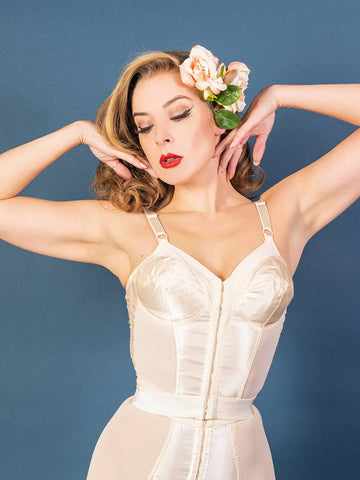
Formal Wear: When it came to formal occasions, women embraced structured lingerie that accentuated their curves and provided a flawless foundation for their attire. This often included longline bras, girdles, and corselettes that offered maximum support and shaping. What Katie Did's collection of vintage style lingerie includes meticulously crafted pieces that replicate the elegance and sophistication of formal 40s and 50s lingerie, with features such as boning, power mesh panels, and intricate stitching.
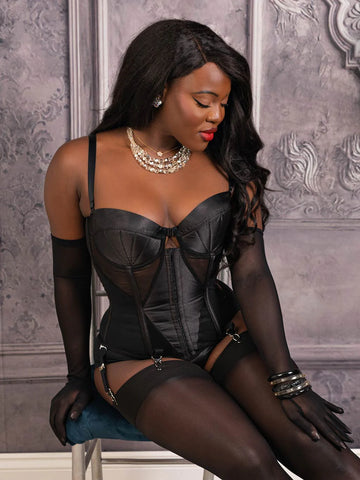
Corselettes are softer on the body than corsets and easier to wear all day.
Step 2: Vintage Inspired Hosiery
Seamed Stockings
Seamed stockings became popular in the early 20th century, particularly during the 1920s, and continued to be a fashionable choice throughout the 1930s, 1940s, and 1950s. They were a staple accessory for women's fashion during this time, accentuating the legs and adding a touch of elegance and sophistication to any outfit.
During the 1920s, seamed stockings were often paired with flapper dresses and skirts, contributing to the overall sleek and streamlined silhouette of the era. In the 1930s, they remained in vogue, complementing the form-fitting styles of the decade with their elongating effect on the legs.
The 1940s saw seamed stockings becoming even more prevalent, as they were worn by women during World War II as part of their everyday attire. Despite wartime rationing and shortages, women still sought to maintain a sense of style and femininity, and seamed stockings were an essential part of their wardrobe.
The 1950s witnessed the peak of seamed stockings' popularity, as they became synonymous with the glamorous pin-up aesthetic of the era. Iconic figures like Marilyn Monroe and Bettie Page helped popularize the look, and seamed stockings became a symbol of feminine allure and sensuality.
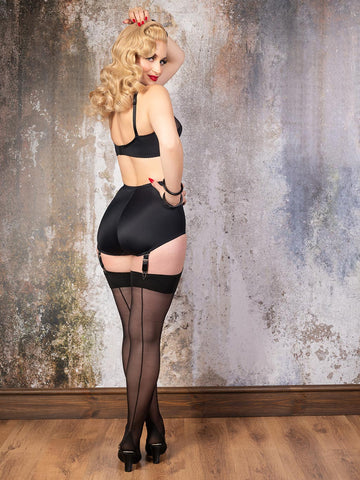
Style Tip: How To Keep the Seam Straight in Seamed Stockings
Before sliding your stockings up your legs, gently roll them down to the toe area, making sure the seam is positioned straight along the back of the leg. Then, carefully gather the material on either side of the seam with your fingertips, ensuring it stays taut and flat against your skin.
Next, slowly and gradually pull the stockings up, keeping a firm grip on the material to prevent twisting or bunching. As you reach the top of your leg, double-check that the seam is still running perfectly straight from the heel to the top of the stocking.
Step 3: Picking Your Outfit
Casual Daytime Wear (50s Style)
The 50s was all about femininity and glamour, but a daytime casual outfit also called for practicality. Generally this was achieved through separates or day dresses, for example:
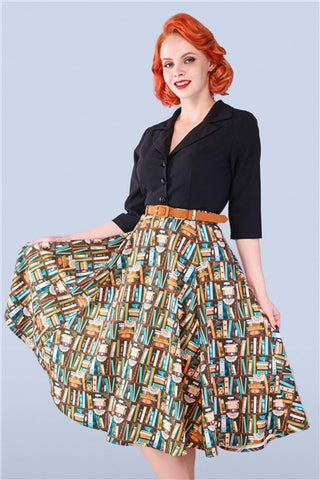
-
Blouse or Sweater: Women in the 1950s often wore blouses or sweaters as the top half of their casual ensemble. Blouses were typically tailored and feminine, often featuring Peter Pan collars, button-down fronts, or tie-neck details. Sweaters were also popular, with classic styles including cardigans, crew necks, and twin sets.
-
Circle Skirt or Capri Pants: For the bottom half of the outfit, circle skirts and capri pants were go-to choices for casual wear. Circle skirts were full and voluminous, typically worn at knee length and featuring playful prints or solid colours. Capri pants, on the other hand, were cropped trousers that hit just below the knee, offering a more tailored and streamlined look.
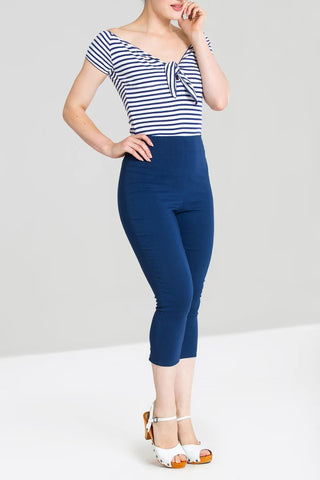
-
Flats or Low Heels: Comfort was key when it came to footwear for casual 50s outfits. Women often opted for flats or low heels, such as ballet flats, loafers, or kitten heels. These shoes were both practical and stylish, providing the perfect finishing touch to a casual daytime look.
-
Accessories: Accessories played a crucial role in completing a 1950s casual outfit. Women often adorned their ensembles with accessories such as scarves, belts, and jewellery to add personality and flair. Scarves were worn around the neck or tied in the hair, while belts cinched the waist and emphasized the hourglass silhouette.

The Erin Bag, pictured above is an elegant and versatile 50s style handbag. -
Handbag: A stylish handbag was the perfect accessory to carry all of life's essentials while on the go. Popular handbag styles in the 1950s included structured top-handle bags, clutch purses, and boxy satchels, often made from leather or fabric in coordinating colours with the outfit.
Overall, a typical 1950s casual outfit for a woman embraced femininity, sophistication, and practicality, with tailored separates, playful prints, and carefully chosen accessories coming together to create a timeless and effortlessly chic look.